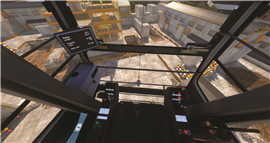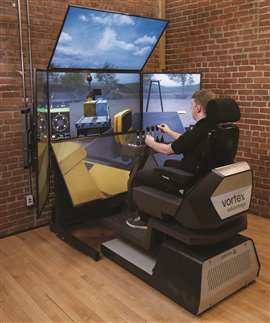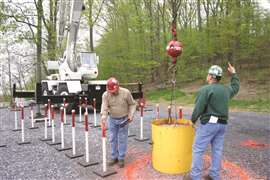Can in-the-seat training be replaced?
10 October 2023
As our industry continues to fight the battle against the labor shortage, training and training methods are always a hot-button topic. While simulator and virtual reality (VR) training technology continues to become more advanced, emphasis on “in the seat” training is still very important. Balancing the two, and implementing both hands-on and technological training is a crucial element of successful certification training.
 ITI believes that test candidates who have engaged in simulation training prior to taking a test score better than test candidates who have not had the opportunity to engage in simulation training. A random sample of scores on pracitce exams were about the same.
ITI believes that test candidates who have engaged in simulation training prior to taking a test score better than test candidates who have not had the opportunity to engage in simulation training. A random sample of scores on pracitce exams were about the same.
Uptick in usage
Industrial Training International (ITI) is paving the way for virtual training in the industry. The company utilizes virtual reality (VR) based crane simulators that were originally brought to market with a partner development studio. Additionally, ITI VR Crane & Equipment Simulators feature makes and models from leading original equipment manufacturers, who were brought into the development process to help ensure an experience on par with operating the exact machinery each simulation was designed to replicate.
ITI Simulations also offers an expansive VR training suite featuring varied scenarios and operator learning paths that provide the range of challenges and skill-building modules needed to turn beginners into experts.
“We’ve certainly seen an uptick in the usage and acceptance of simulator-based training as a viable education method over the past few years,” said ITI. “This can be attributed to a variety of industry factors including analyses such as an NCCCO Foundation-sponsored study on the efficacy of virtual reality VR Crane Simulation, which was conducted by a third-party psychometrician, which was published in 2020.”
ITI also cites the impact that the Covid-19 pandemic had on society, helping to prompt basically everyone to fast-forward ten years’ time in terms of willingness to adopt new forms of technology while in-person contact was limited.
“In addition to increased utilization of remote learning options, we watched as virtual reality adoption skyrocketed as it provided a training option when in-person sessions were not always possible,” the company added.
ITI believes that test candidates who have engaged in simulation training prior to taking a test score better than test candidates who have not had the opportunity to engage in simulation training. The study referenced previously found that a random sample of an operator’s score on a practice certification exam conducted in VR predicted the same operator’s score on the actual exam to a 95 percent confidence interval.
Working in tandem
Despite the emphasis on technological training, ITI still encourages in-the-seat training a vital necessity of operator preparation.
“We believe that operator seat time and experience is not only essential, but in truth the backbone of a competent crane operator,” said ITI. “That being said, what we encourage our industry mates to remember is that the goal has at no point been to replace in-the-seat training. The goal of simulation training is to work in tandem with traditional training methods by offering more seat time, reduce downtime and ultimately provide a safe and efficient learning environment – and thus play a role in reducing expenses while improving efficiency, and implement an enhanced training solution that compliments other forms of education for those who are new to the industry and/or working to remain current or even achieve new certifications.”
While it’s not one size fits all, the company believes that an optimal learning path is one that incorporates a combination of Instructor Led Training, eLearning, simulation time and time spent practicing and working on the actual equipment in the real world.
A regular role
Inspired by the normalization and successes of flight simulators over the last ten years, CM Labs has been hoping to lead the way into a safer future where simulation plays a regular role in heavy equipment operator training.
 With over 1,000 simulation installations in 39 countries, CM Labs offers a realistic experience through its Smart Training Technology.
With over 1,000 simulation installations in 39 countries, CM Labs offers a realistic experience through its Smart Training Technology.
With over 1,000 simulation installations in 39 countries, CM Labs offers a realistic experience through patented Smart Training Technology and a motion-enabled platform. The Simulation Training Packs provide a comprehensive immersive simulation learning program for the safe training and assessment of operators.
“But even though we are advocates for simulation, nothing will completely replace the real machine,” said Christa Fairchild, product marketing manager, CM Labs. “Operators must learn to know and expect every reaction out of the machines and be prepared for these reactions and movements. Simulation training helps prepare operators for those moments and is the bridge between theory and operating on the job.”
The CM Labs’ full-motion platform is tied, in real-time, to the simulation and accurately replicates much of an operator’s day-to-day experience, through the seat as well.
“Trainees improve their muscle memory ultimately to be ‘one’ with their equipment: feeling the platform bowing down as they drill or dig, pitching at risk of tipping or feeling engine vibrations through the seat to avoid choking the throttle,” said Fairchild. “The simulation replicates true engine sounds (including fails and stalls), variable engine RPMs, horns, scraping and shifting, alarms and other work site sounds that are important audio cues for safe, steady, deliberate and precise operations.”
In the future, CM Labs is expecting to see an increase in VR and simulator usage for certification and believes that simulator training is key to successful operators lasting in the construction industry.
CM Labs solutions include simulation exercises to prepare for certifications for Forklift, NCCCO and EICA for Digger Derrick, and NCCER and NCCCO testing for Cranes. Electrical Training Alliance (ETA), the curriculum arm for the International Brotherhood of Electrical Workers (IBEW), collaborated with CM Labs to add specialized training scenarios for utility industry certifications.
The simulation exercises, inspired by the certification requirements, mirror exact applications, such as auger control, and pole control and setting, rather than generic scenarios. This translates directly into higher success rates as trainees are better prepared for both written and practical exams, the company said.
Whether simulated practical testing in North America will be accepted by certification bodies as equivalent to practical testing on real equipment is yet to be seen, the company said. But a 2020 study by NCCCO suggests that this type of testing is “a highly reliable measure for predicting a passing score on an actual crane.”
CM Labs also believes that the industry will see more training paths customized to fit individual operator learning profiles.
“Today’s simulators are data and analytics-driven, which is essential to optimizing training time and correcting unsafe behaviors,” said Fairchild. “This means that training techniques move away from a checklist approach, and instead target specific skills that make people more efficient and safer.”
Supplementing training
Stephenson Equipment offers several classroom training facilities and practical training facilities in Pennsylvania. The company has previous experience utilizing VR technology to supplement hands-on training classes, but believes that even when using a simulator, potential operators should be given instruction concerning how to operate a crane.
 Stephenson Equipment believes in a more traditional approach, and offers several classroom and practical training facilities.
Stephenson Equipment believes in a more traditional approach, and offers several classroom and practical training facilities.
“The issue is, VR can be used to supplement hands-on training, but we realized, candidates that are desiring to learn to operate a crane need to be in the crane,” said Ray Feidt, corporate inspection/training manager, Stephenson Equipment. “As good as VR is, it just cannot replace real seat time with instruction.”
Feidt said it is also impossible to recover the cost of a VR simulator.
“Where it will work is if a contractor wants to get their potential crane operators practice time and not have to use a crane,” he added. “Contractors wouldn’t be concerned about making money with it. Does VR have its place? Probably. Is it good enough to replace seat time and actual operational instruction? No!”
Stephenson sees that most potential crane operators do not learn the techniques that are required to operate a crane efficiently and safely just by practicing on their own. There still remains a significant need for in-person and in-the-seat instruction.
“With instruction, potential crane operators learn the proper techniques so when they do practice, they practice working on the proper techniques,” added Feidt. “Then they hone their skills to the point where applying the techniques becomes automatic. So, even using a VR simulator, potential operators should be given instruction concerning how to operate a crane.”
STAY CONNECTED


Receive the information you need when you need it through our world-leading magazines, newsletters and daily briefings.




